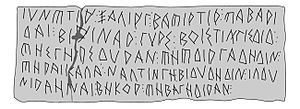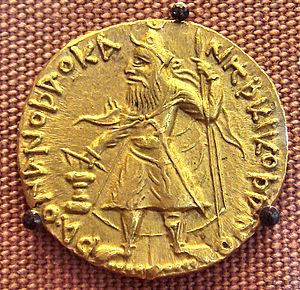Sampi facts for kids
Sampi (modern: ϡ; ancient shapes: ![]() ,
, ![]() ) is a very old letter from the Greek alphabet. It was used a long time ago, around the 6th and 5th centuries BC, in some parts of ancient Greece, especially in the eastern Ionic areas. Sampi was used to make a special "s" sound, maybe like "ss" or "ts." But when this sound disappeared from the Greek language, the letter Sampi was no longer used for writing words.
) is a very old letter from the Greek alphabet. It was used a long time ago, around the 6th and 5th centuries BC, in some parts of ancient Greece, especially in the eastern Ionic areas. Sampi was used to make a special "s" sound, maybe like "ss" or "ts." But when this sound disappeared from the Greek language, the letter Sampi was no longer used for writing words.
However, Sampi found a new job! It became a number symbol for 900 in the Greek number system. Its modern shape, which looks a bit like the letter π leaning to the right with a long, curved line, developed much later during the Byzantine era when people wrote it by hand.
The name sampi is also quite new, from the Middle Ages. It probably means "like a pi" (san pi). We don't know what the letter was called in ancient times. Some people think Sampi might be connected to an even older letter called san, which looked like an M and made an "s" sound in other Greek dialects.
Contents
Sampi as a Letter
Sampi was used as a letter to represent a specific sound, mostly between the mid-500s and mid-400s BC. It looked like ![]() . We've found it in ancient cities like Miletus, Ephesus, Halicarnassus, and Samos. It was also used in places like Massilia and Kyzikos. On coins from Pontic Mesembria, Sampi was part of the city's name, spelled "ΜΕͲΑ".
. We've found it in ancient cities like Miletus, Ephesus, Halicarnassus, and Samos. It was also used in places like Massilia and Kyzikos. On coins from Pontic Mesembria, Sampi was part of the city's name, spelled "ΜΕͲΑ".
This letter appeared in words where other Greek dialects, like Ionic Greek, used a double "sigma" (σσ), which was a long "ss" sound. For example, the word for 'sea' was θάλασσα in Ionic Greek. In other dialects, like Attic Greek, they used ττ (a long "tt" sound) for the same words, so 'sea' was θάλαττα.
Scientists believe Sampi was used for a sound that was somewhere in between these "ss" and "tt" sounds, possibly an "affricate" sound like "ts." This was during a time when the Greek language was changing.
One of the earliest examples of Sampi as a letter is from a list of alphabet letters found in Samos, dating back to the mid-600s BC. This shows that Sampi was invented around the same time as the letter omega.
The first time we see Sampi used in actual Greek words is on a silver plate from Ephesus. It has the words "τέͳαρες" ("four") and "τεͳαράϙοντα" ("forty") written with Sampi. This plate is from the late 600s to mid-500s BC.
Pamphylian Sampi
There was another letter, similar to Sampi, used in a different Greek dialect called Pamphylian Greek in southern Asia Minor. It looked like ![]() . We don't know if it's directly related to the Ionian Sampi. This Pamphylian Sampi was found in a few old writings and on local coins. For example, an inscription from Perge (around 400 BC) uses it in the name of the goddess Artemis, who was called the "Queen of Perge."
. We don't know if it's directly related to the Ionian Sampi. This Pamphylian Sampi was found in a few old writings and on local coins. For example, an inscription from Perge (around 400 BC) uses it in the name of the goddess Artemis, who was called the "Queen of Perge."
Sampi as a Number
In the Greek number system, which probably started in Miletus, there were 27 signs for numbers. The first nine letters (like alpha for 1) were for single digits. The next nine (like iota for 10) were for tens. And the last nine (like rho for 100) were for hundreds.
To make 27 signs, they used the 24 letters of the regular Greek alphabet plus three old letters:
Digamma and Koppa kept their original spots in the alphabet, but Sampi was added at the very end, after omega (which was 800). This suggests that the number system was created when people still remembered Digamma and Koppa, but Sampi was a newer addition for numbers.
Historians have debated when this number system, including numeric Sampi, first appeared. Some believe it was fully developed by the 3rd century BC, while others think it goes back to the 6th century BC.
Actual examples of Sampi being used as the number 900 are not found in very early writings. The earliest known use of numeric Sampi on a stone is from the 2nd century BC in Magnesia on the Maeander. In Athens, it first appeared in the early 2nd century AD, also for sums of money.
Before it was used for 900, Sampi was sometimes used in Athens to list things in a sequence, like marking items from 1 to 25. For example, there were 25 metal tokens from the 4th century BC, each stamped with a letter from alpha to Sampi. These were likely used to identify judges in Athenian courts.
In ancient papyrus texts from the Ptolemaic period onwards, numeric Sampi appears more regularly.
Interestingly, in early papyri, Sampi was sometimes used not just for 900, but also to multiply by 1000. For example, writing an alpha over Sampi (![]() ) meant "1 x 1000." This system was later simplified, using a small stroke to the left of a letter to mean "times 1000" (͵α = 1000).
) meant "1 x 1000." This system was later simplified, using a small stroke to the left of a letter to mean "times 1000" (͵α = 1000).
How Sampi's Shape Changed
In early stone writings, Sampi, both as a letter and a number, looked like ![]() . It had a square top. Other early forms in papyri also had square tops, sometimes with the middle line being longer.
. It had a square top. Other early forms in papyri also had square tops, sometimes with the middle line being longer.

The first description of Sampi's shape comes from a 2nd-century AD doctor named Galen. He said it "looks like the letter Π with a vertical line in the middle."
Over time, handwritten Sampi started to have rounded tops (![]() ) or pointed tops (
) or pointed tops (![]() ). Later, in the Roman period, these shapes often gained a loop connecting the two lines on the right, looking like an "ace of spades" (
). Later, in the Roman period, these shapes often gained a loop connecting the two lines on the right, looking like an "ace of spades" (![]() ). Sometimes, another decorative line was added on the left.
). Sometimes, another decorative line was added on the left.
Finally, from these shapes, the modern form of Sampi emerged around the 9th century, with its two straight lines becoming more or less parallel (![]() ).
).
Where Sampi Came From
For a long time, many experts thought Sampi was a continuation of an older letter called san (Ϻ). San was an M-shaped letter that was part of the Greek alphabet when it first came from the Phoenician alphabet. San made an "s" sound and was used in some dialects before being replaced by "sigma."
The idea that Sampi and San are the same comes from a few things:
- They both made similar "s" sounds.
- There were three old Greek letters that fell out of use (digamma, koppa, and san), and three extra letters were added to the number system (digamma, koppa, and sampi). It seemed logical that Sampi was the third.
However, there are problems with this idea. Sampi didn't have the same place in the alphabet as San, and their shapes don't look very similar.
Another idea is that Ionian Sampi might have come from the Anatolian language Carian, which was spoken in the area where Sampi was used. This is still being studied, as we don't know everything about the Carian language yet.
Even with these debates, almost everyone agrees today that the Sampi used as a letter (for the "ss" sound) and the Sampi used as the number 900 are the same character.
Names for Sampi
The name sampi is generally thought to be quite new, from the Middle Ages. It's not what the letter was called in ancient times. It probably appeared after the 13th century.
The name sampi is found in old Slavic texts from around 1200 AD, which describe the Greek alphabet. In Western Europe, the name sampi first appeared in the 17th century in the writings of Joseph Scaliger.
The most accepted explanation for the name sampi today is that san pi (σὰν πῖ) simply means "like a pi." Here, san is a Greek word meaning "like," not related to the old letter san.
Because there wasn't a single official name for Sampi, people in Byzantine times used different general terms. For example, a 15th-century mathematician called it "the so-called charaktir" (just "the character").
In some old Latin documents from Western Europe, Sampi was simply called by the Greek word for its numeric value, enneakosia ("nine hundred"). This name sometimes got changed into words like enacosis or sincope.
A very strange name for Sampi found in one Greek text is "παρακύϊσμα" (parakyisma), which literally means "a false pregnancy." Some think this might refer to its unusual, added status, while others believe it's a mistake in the text.
A new idea suggests that the original name for the letter in ancient Greek might have been angma (ἄγμα). This name might have come from a word meaning "to bend" or "curve," referring to the letter's hook-like shape.
Sampi in Other Alphabets

The Greek alphabet was used to write other languages too, and Sampi sometimes appeared in them:
- In the Greco–Iberian alphabet, used in Spain around the 4th century BC, Sampi was adopted as a letter for a different "s" sound. It looked like
 .
. - The Bactrian language, spoken in Afghanistan, used a Greek-based script with an extra letter Ϸ for an "sh" sound. Some think this letter might be connected to Greek Sampi or San.
- In the Coptic alphabet, the sign "Ⳁ" (
 ) was used for 900.
) was used for 900. - The Gothic alphabet used a form of Sampi that looked like an upward-pointing arrow (
 ) for 900.
) for 900. - In the Glagolitic alphabet (an old Slavic writing system), the letter
 was used for 900. In Cyrillic, the letter Ц took its place.
was used for 900. In Cyrillic, the letter Ц took its place. - In Armenian, the letter Ջ stands for 900.
Modern Use of Sampi
Sampi is still used in Greece today, along with other Greek numerals. However, it's not very common because the system is mostly used for smaller numbers, like chapters in a book. You'll rarely see Sampi in everyday life.
One place where you might still see Sampi is in Greek law, because laws were numbered using this system until 1914. For example, a law might be called "Νόμος ͵ΓϠΝʹ/1911" (Law Number 3950 of 1911), where Ϡ is Sampi for 900. But even then, people often just use the letter π instead of the actual Sampi symbol.
Sampi in Fonts and Computers
When modern printing started, printers used the smaller, handwritten version of Sampi, ϡ, in their fonts. The way Sampi looks in print has changed a lot over time. You can find many different shapes today, from small, π-like shapes (![]() ) to ones with big curves (
) to ones with big curves (![]() ).
).
When Sampi is used as a number, there's usually no difference between its uppercase and lowercase forms in print. However, Unicode (a system for coding characters on computers) decided to create separate codes for uppercase and lowercase Sampi. This has led to different designs in fonts.
The ancient Ionian Sampi (Ͳ) is usually not shown with the modern Sampi symbol in print. In academic studies of old writings, it's either shown as Ͳ or sometimes as a Latin capital T. Since it's now in Unicode, new font designs are being made for it.
Computer Codes for Sampi
Sampi and its different forms have special codes in Unicode so computers can display them.
- U+03E0 is for the Greek Letter Sampi (uppercase).
- U+03E1 is for the Greek Small Letter Sampi (lowercase).
- U+0372 is for the Greek Capital Letter Archaic Sampi.
- U+0373 is for the Greek Small Letter Archaic Sampi.
Other related characters like the Bactrian "sho" and the old Greek "san" also have their own Unicode codes.
Images for kids
See also
 In Spanish: Ϡ para niños
In Spanish: Ϡ para niños



































